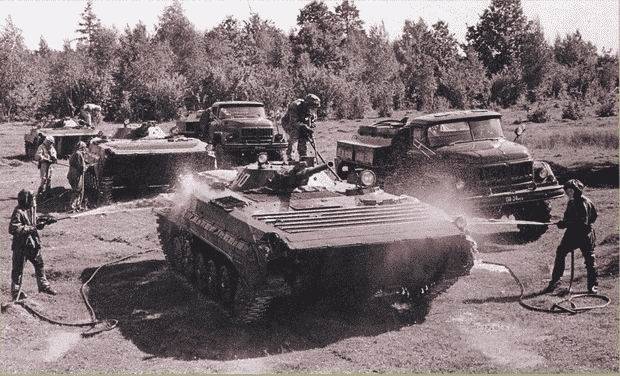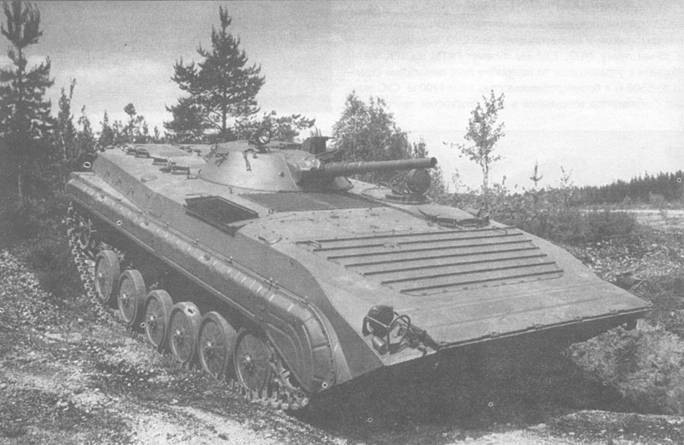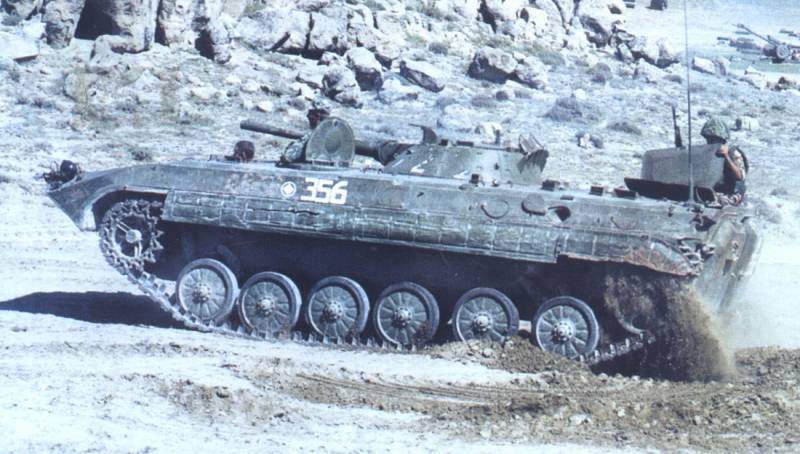BMP-1: The Chariot of Nuclear Battle
At the same time, the BMP-1 was one of the most popular types of armored vehicles, there were about 20 thousand of them produced, and in the production of the BMP-1 was from 1966 to 1983 years. It may seem surprising that a combat vehicle with complete flaws was produced by such a large series. You might think that this is another example of domestic stupidity.
However, do not rush. When this car was done, the Soviet Army command consisted of people with the experience of the Great Patriotic War, who fairly smelled gunpowder. It is hardly possible to assume that in the post-war years all these officers were so stupid that they allowed this tracked drawback to mass production. They certainly understood well the nature of the war for which they were preparing, and the BMP-1 fully met their requirements. Otherwise they would have chosen some other construction.
Any military equipment is done under a certain tactic. Even if the command, for whatever reason, did not wish to make public what exactly it demanded from the designers, the combat vehicle itself still has a clear imprint of their plans, and these requirements can be inferred from the peculiarities of its design. In general, I believe that the BMP-1 was a good fighting vehicle, it just did not take part in the war for which it was created.
Critics of the BMP-1 almost always lose sight of what the car was different from all the other armored personnel carriers, namely, a curious combination of qualities: anti-nuclear protection and automatic sealing of the hull, anti-radiation podboi and ability to swim. It was the first in the world model of serial armored vehicles in which these qualities were combined. The BTR of the likely enemy, such as the American M113 and the German HS.30, did not have anti-nuclear protection and could not swim.
BMP-1 is among other Soviet armored vehicles that had anti-nuclear protection. Besides her, there were still Tanksstarting from T-55, and self-propelled guns starting from 2C3 "Acacia". Anti-nuclear defense provided protection against a shock wave of a nuclear explosion at a distance of about 800 meters from the epicenter of a tactical nuclear explosion (up to 20-30 kt) for tanks, and at a distance of about 1000-1200 meters for infantry fighting vehicles and self-propelled guns. Armored vehicles could receive some damage, but the crews survived and did not lose their combat effectiveness. Armor steel protected not only from the shock wave, but also from penetrating radiation. Radioactive dust could be washed off later, after the end of the battle.

Thus, a Soviet tank or motorized rifle division during the cold war could have fought near a nuclear explosion. In the previous article I already gave some information about the tactics of the offensive with a nuclear firing shaft, that is, the first strike was inflicted by tactical nuclear munitions (tactical missile or special equipment for self-propelled guns), and then the armor had to quickly go through the area of a nuclear explosion, finish off the enemy, if there was one, and escape further into the operational depth.
With this method of warfare, it becomes quite obvious that the BMP-1 on the field of nuclear massacre simply should not have opponents capable of firing from large-caliber machine guns, RPGs or small rifles. weapons near. The BMP-1 didn’t expect that the enemy’s infantry would surround it and start watering the vehicle with small-arms fire. In the area of a nuclear explosion, the enemy infantry will already lie dead, severely burned or strongly contused, in general, incapable of combat. Moreover, the BMP followed the tanks to the explosion site at some distance (about a kilometer or a bit more) and overcame the enemy’s defenses after the tanks had finished most of the survivors. Mine, of course, also should not be, because they detonate from a powerful shock wave of a nuclear explosion.
The only thing that posed a danger was the tanks and armored personnel carriers of the enemy with under crews. To combat them, the BMP-1 was equipped with the 2А28 Thunder, essentially an anti-tank grenade launcher, as well as the 9М14М Maly ATGM. Moreover, the priority target for the BMP-1 was the German BTR HS.30, armed with the 20-mm cannon HS-820, which is armed with the Bundeswehr, which was about 60% of NATO forces in West Germany. In a frontal bout of the German and Soviet vehicles, the German BTR had no chance: the frontal armored BMP-1 defended well against 20-mm projectiles, but HS.30 had nothing to oppose with the 73-mm cumulative grenade. The same can be said about the M113. Armor BMP-1 held a bullet 12,7-mm machine gun M2HV, while the cumulative grenade easily pierced the aluminum armor of the American BTR.
Buoyancy was needed for BMP-1 bypass. For example, there is a task to take a large bridge over the river, which protects the bridgehead - Brückenkopf. Since the bridge must be taken as a whole, the nuclear charge is not used. Tanks and self-propelled guns go into a frontal attack, and motorized infantry on an infantry fighting vehicle must swim across the river several kilometers from the bridge, and then attack the bridge and its defenders from the rear. This is the most effective way to capture bridges, well developed during the Great Patriotic War.
So, the BMP-1 was perfectly suited to perform typical tasks in the context of a nuclear war, when the main forces and equipment of the enemy were destroyed and suppressed by nuclear strikes. For these tasks, the car was armed not so well, and even excessively powerful, so to speak, with a guarantee. The designers also tried to improve the car due to the small height and small silhouette (which was important for protection from the shock wave of a nuclear explosion, and for reducing visibility for the enemy, and for making it difficult to defeat; however, they had to sacrifice the comfort of motorized infantry in the troop compartment). placed at the corners of armor plates. They also took care of the power reserve, having developed a clever idea to turn the doors of the troop compartment into additional tanks.

Try to think of something better for the nuclear battle than the BMP-1.
But such a large-scale war with the abundant use of nuclear weapons did not happen. And in the conditions of other wars in which armored vehicles found themselves in a variety of situations, the BMP-1 was no longer suitable, because its merits turned to disadvantages and the anti-nuclear protection was not needed.
So do not rush to criticize, if it seems that they have developed and massively produced an allegedly unsuccessful, with a lot of flaws, a sample of military equipment. Perhaps you just misunderstand something.

Information